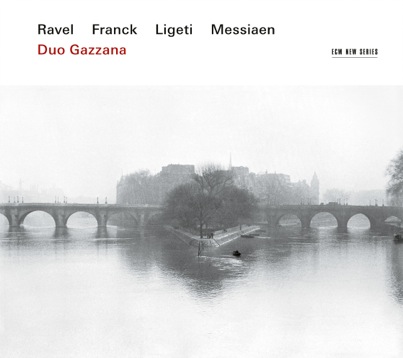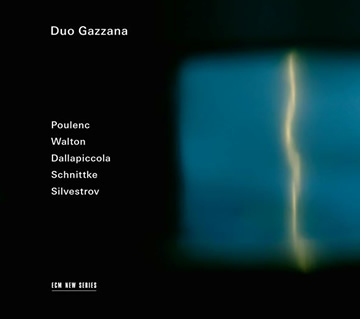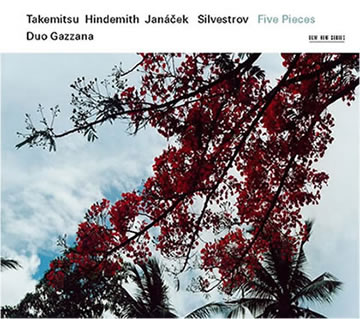BUY
https://ecmrecords.com/product/korvits-schumann-grieg-duo-gazzana/
Duo Gazzana
Kõrvits / Schumann / Grieg
Natascia Gazzana: violin; Raffaella Gazzana: piano
ECM New Series 2706 CD 0289 4858117 7
Prior recordings by Duo Gazzana have seen the Italian sisters garner much praise and critical acclaim for their “imaginative playing, and willingness to color outside the customary lines” (Fanfare). The BBC Music Magazine called their interpretation of César Franck’s Violin Sonata “a masterclass”, and the German Spiegel magazine considers them “one of the most interesting new chamber duos, (…) capable of successfully linking seemingly disparate artists like Ligeti, Ravel and Messiaen with conviction.” In a continued balancing act of combining inventive contemporary works with traditional classical repertoire on ECM New Series, this time the duo of Italian sisters Gazzana ventures back to the 19th century for impassioned interpretations of Robert Schumann’s Sonata op. 105 and Edvard Grieg’s Sonata op. 45. Premiere recordings of Estonian composer Tõnu Kõrvits’s Stalker Suite and notturni, each in four movements, make up the contemporary part of the programme.
Shortly after becoming musical director of the orchestra in Düsseldorf in 1850, Robert Schumann’s mental health started to decline and it is in this period that he wrote his final violin works, including the Violin Sonata No.1 in A minor, from 1851. Like many of his later works, this piece is characterized by a particularly dense thematic concentration. The first movement’s darkly surging main theme, coloured by the sonority of the violin’s rich, husky G string, is one of the composer’s most memorable inventions. Natascia and Raffaella Gazzana connect with the piece on a deeply committed level, making the canonic element of the first movement, ‘Mit leidenschaftlichem Ausdruck’, resonate with special expressiveness. The Allegretto in Rondo form is a brisk intermezzo giving way to the third movement, ‘Lebhaft’, which brings back the canonic structures, calling on some of the duo’s most fervent playing.
For Edward Grieg’s Sonata No. 3 in C minor the Gazzanas opted for the composer’s first copy instead of the first edition of the score, thereby shedding fresh light on Grieg’s final Sonata, which is understood to have been a personal favorite of the composer’s. Norwegian folk melodies and rhythms are transfigured here, as the Sonata navigates from the pressing opening movement ‘Allegro molto ed appassionato’ through a swift romance, ‘Allegretto espressivo alla Romanza’, to the rousing rhythm of the ‘Allegro animato’ that concludes the Sonata. The focus shifts back and forth between violin and piano in the process.
Tõnu Kõrvits’s works contrast this romantic repertoire musically, as well as by their sequencing on the album. NPR has called Kõrvits “a supremely lyrical sensualist”, and his idiosyncratic compositional voice seems to be influenced equally by 20th century minimalism and the practices of his former mentor, the late Estonian master composer Veljo Tormis. But his music floats between the idioms, not abiding by strict sets of rules. Opening the programme is Stalker Suite, in homage to Andrei Tarkovsky and named after the film director’s chef d’œuvre from 1979. This suite, as the four notturni that follow later on, Kõrvits dedicated to the Gazzanas. Both performances are premiere recordings and capture the tonal ambivalence of the composer’s scores with poignancy. Not quite miniatures, nor exactly in song form, the pieces defy conventional structure.
Paul Griffiths draws visual parallels between the film and the composition in his liner note, especially for the suite’s final movement: “‘Waterfall’, in remembering the piano’s repertory of aqueous imagery, remembers too the presence of water in the film, running and still, living and dead. The violin adds a lament. The piece breaks off on the threshold of something it has caught sight of but cannot bring nearer, not now. Or not yet.” The four notturni, composed in 2014 and similar to the Stalker Suite by design, investigate common chords, steadily interspersed with dissonances and textural frictions, creating open yet tense spaces for violin and piano to explore.
The performances were captured in the historic Reitstadel Neumarkt in November 2021 and produced by Manfred Eicher.
*
Natascia and Raffaella Gazzana’s first recording for ECM New Series, Five Pieces from 2011, features works by Takemitsu, Hindemith, Janáček and Silvestrov. A second album, presenting music of Poulenc, Walton, Dallapiccola, Schnittke and Silvestrov followed in 2014. The duo’s last album, from 2018, incorporates works by Ravel, Franck, Ligeti and Messiaen and saw BBC Music Magazine calling it “an authoritative performance. […] the poise the Gazzanas bring to both Ravel and Messiaen is impressive.”

BUY
https://www.ecmrecords.com/catalogue/1516190625/ravel-franck-ligeti-messiaen-duo-gazzana
STREAM
https://ecm.lnk.to/cikR_
Ravel – Franck – Ligeti – Messiaen
Duo Gazzana
Natascia Gazzana, violin Raffaella Gazzana, piano
ECM New Series 2556 Release: 20 April 2018
The third ECM New Series recording by Italian sisters Natascia and Raffaella Gazzana focuses primarily on French music, by César Franck, Maurice Ravel and Olivier Messiaen, and also pays tribute to Hungary’s György Ligeti, with a premiere recording of his Duo for violin and piano.
Where 20th and 21st century music was explored on their two previous discs – the first with music of Takemitsu, Hindemith, Janáček and Silvestrov and the second with Poulenc, Walton, Dallapiccola, Schnittke and, again, Silvestrov – this time Duo Gazzana also reaches back a little further in music history. The album begins with two pieces composed at the end of the 19th century, Ravel’s Sonate posthume, written in 1897, and César Franck’s monumental A-major Sonata for piano and violin of 1886.
“If you speak of French music, the first association is probably with music where atmosphere and mood are emphasized,” the Gazzana sisters note. “But the Franck sonata is something really solid as well as beautiful, and it has influenced so many other composers.” As Wolfgang Sandner remarks in the CD booklet essay, “The sonata is a test of interpretation. In particular, it requires a command of its architecture, built through successive cycles, of its expressive intensity, product of a formal clarity maintained through harmonic boldness, enharmonic ambiguities and modulations to distant keys, and not least the dialogue that develops between the two instruments.”
Studying and playing the Franck sonata was Duo Gazzana’s starting point for the repertoire of the present disc. “And then we tried, as we always do in our programmes, to find links and interconnections, musically and historically.”
Three of the featured pieces are early works. Maurice Ravel was just 22 when he wrote the Sonata posthume (which remained unpublished until 1975), Olivier Messiaen composed his Thème et variations at 24, and György Ligeti wrote his Duo (dedicated to his good friend György Kurtág) aged 23. The Gazzana sisters, who gave eloquent voice to early William Walton on their last ECM album, are fascinated by the transitional character and the promise of such pieces: “In them, you can already hear and sense the next steps that these composers will make in their musical language.” Early potential is also embodied in the Franck A major sonata: completed when its author was in his mid-60s, it was built upon a work he had sketched some three decades earlier.
The Franck, Ravel and Messiaen pieces reflect upon their authors’ close relationships with great violinists. Franck dedicated his sonata to a fellow composer, the virtuoso violinist Eugène Ysaӱe. Ravel’s 1897 sonata is said to have been inspired by the playing of his friend George Enescu, when both musicians were members of Fauré’s composition class in Paris. And Messiaen’s Thème et variations is dedicated to his first wife Claire Delbos, who gave the premiere performance. The profound keyboard skills of César Franck and Olivier Messiaen are however not to be gainsaid, and both had reputations as outstanding organists and improvisers. Raffaella Gazzana: “In some of the demanding counterpoint of the 4th movement of his sonata, especially, one can imagine Franck thinking also of the foot pedals of the organ.”
Messiaen and Ligeti were universes unto themselves: “Neither of them can really be classified in terms of any school.” Regarding the inclusion of the György Ligeti piece here, the duo says, “we like Ligeti’s music very much, but he didn’t publish music for our instrumentation. After doing some research we found a mention of the early Duo, and went in search of the piece.” In contradistinction to the Franck piece, where any new interpretation must take into account many distinguished recorded performances, “it was interesting and challenging to play the Ligeti with no other reference than the notes on the newly-printed Schott score.”
Paul Griffiths’s commentary on Duo Gazzana’s 2011 debut can serve equally as a summary here: “The programme as a whole is typical of the duo’s inquiring and sensitive approach to repertory. What we hear here is a vital freshness.”
Like its predecessors, the album was recorded at Lugano’s Auditorio Stelio Molo RSI, and produced by Manfred Eicher.
– – – – – – – – – – – – – – – – – – – – – – – – – – – – – – – – – – – – – – –

BUY
https://www.ecmrecords.com/catalogue/143038752869/poulenc-walton-dallapiccola-schnittke-silvestrov-duo-gazzana
STREAM
https://ecm.lnk.to/DuoGazzana_DuosViolinPiano
Poulenc – Walton – Dallapiccola – Schnittke – Silvestrov
Duo Gazzana
Natascia Gazzana, violin Raffaella Gazzana, piano
ECM New Series 2356 Release: 4 April 2014
Duo Gazzana’s second album for ECM New Series unites works from the 20th and 21st centuries with striking narrative character and retrospective glance at music history. Composers from France, Great Britain, Italy, Russia and Ukraine present earlier musical forms – toccata, suite, canons, variations – in the light of new developmental techniques, thereby revealing similarities and relations across centuries, geographical boundaries and contrasting forms of expression.
Alfred Schnittke’s Suite in the Old Style is indeed a playful if unconventional allusion to compositional style of the past. Hommage à J.S.B., by the Ukrainian living composer Valentin Silvestrov, evokes variations on themes of the Leipzig master. Similarly Luigi Dallapiccola, in his divertissement Tartiniana seconda, responds with contrapuntal mastery to the music of the Baroque composer Giuseppe Tartini. William Walton’s rarely heard Toccata, written when he had just turned 20 years old, virtually overflows with structural ideas related to the virtuosic demands of traditional toccata form. The cadenzas for both the violin and the piano call for quasi-improvisational skills that draw rhythmic impetus from jazz. Vitality and vehemence inform also Francis Poulenc’s dramatic Sonate, here representing the evolution, on a structural and formal basis, of the simplest and earliest musical forms (toccata, suites, divertissement and variations) used in the compositions of this album. Written in 1942-43 it is dedicated to the memory of the Andalusian poet Federico García Lorca. A line, from one of his poems: ‘La Guitare fait pleurer les songes’ (The guitar makes dreams weep) inspired the second contrasting movement, an expressive intermezzo in the manner of a dirge.
The Gazzana sisters, Natascia and Raffaella, were born in Sora near Rome and formed the Duo Gazzana in the mid-1990s. Their joint musical education allowed them to develop a great sensitivity toward the conversational demands of subtle chamber music; moreover, they both took additional degrees at La Sapienza University in Rome – Natascia in visual arts, Raffaella in musicology, presenting a critical review of Walton’s Toccata for her dissertation.
The two artists studied in Rome, Geneva, Brussels, Siena, Lausanne, Fiesole and Salzburg and received inspiration from a large number of prominent teachers, including Bruno Canino and the Trio di Milano, Yehudi Menuhin, Corrado Romano, Uto Ughi, Piero Farulli, Pierre Amoyal, Pavel Gililov and Ruggiero Ricci. They have given recitals in many European countries, Africa, Oceania and Asia and cultivate special relations with the Far East, including guest performances in Japan, Vietnam, South Korea, Singapore and Hong Kong, where they have also held master-classes. Fives Pieces, their first recording for ECM New Series, featuring works by Takemitsu, Hindemith, Janáček and Silvestrov, was released in 2011.
This album was recorded in the Auditorio Radiotelevisione svizzera in Lugano in June 2013 with Manfred Eicher producing.
– – – – – – – – – – – – – – – – – – – – – – – – – – – – – – – – – – – – – – –

BUY
https://www.ecmrecords.com/catalogue/143038752771/five-pieces-takemitsu-hindemith-janacek-silvestrov-duo-gazzana
STREAM
https://ecm.lnk.to/DuoGazzana_FivePieces
Takemitsu – Hindemith – Janácek – Silvestrov / Five Pieces
Duo Gazzana
Natascia Gazzana, violin, Raffaella Gazzana, piano
ECM New Series 2238 Release: 23 September 2011
This is the recording debut of Italian sisters Natascia and Raffaella Gazzana, named for the “Five Pieces” for violin and piano by Valentin Silvestrov which conclude the album. These works – a gently-pulsing elegy, a serenade, an intermezzo, a barcarole, a ghostly nocturne – receive their international release here in a context which combines the familiar and the far-flung, as Duo Gazzana finds creative affinities between the music of four very different composers. “The programme as a whole is typical of the duo’s inquiring and sensitive approach to repertory”, writes Paul Griffiths in the liner notes. “What we hear here is a vital freshness”.
Unorthodox perspectives inform both the programme and the duo’s approach to it. The album begins with Toru Takemitsu’s “Distance de fée”, written in 1951 when the composer, as yet in pursuit of a stylistic identity, was still strongly influenced by Messiaen and Debussy, Europeans who themselves were looking eastward for inspiration. Distance and proximity are underlying themes here. Two worlds, Wolfgang Sandner suggests, are combined yet not reconciled in “Distance de fée”, which nonetheless anticipates the haiku-like vividness of later Takemitsu, the composer who would say, “I’d like to produce sounds that are as intense as silence.”
Paul Hindemith’s 1935 Sonata in E, travelling from pastoral beginnings to harmonic complexity, offers challenges to which the Duo Gazzana respond adroitly, likewise the Janácek Violin Sonata with its balance of lyrical flow and expressive gestures. One historical connection between the two works is that Hindemith gave the international premiere of the Janácek piece in Frankfurt in 1923. Janácek had begun the Sonata in 1914 as the First World War was erupting (“I could just about hear the sound of the steel clashing in my troubled head”, he would later write), and continued to revise the music over the next several years. It is one of his most concentrated chamber pieces, packing a wealth of detail into its four movements, and also amongst his must impassioned music, juxtaposing dense writing in the piano and expansive thematic material in the violin. Contrasts are explored, also with conflicting elements, as in the final movement where – as critic John Tyrell has remarked – ‘interruption motifs’ from the violin, tiny repetitive fragments, challenge the broad-arched melodies of the piano.
The album “Five Pieces” was recorded in March 2011 in Auditorio Radiotelevisione svizzera.


